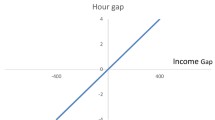Abstract
Little adjustment in labor or leisure time is possible because of standardized work weeks in many countries. Without such labor-leisure adjustment, the logic of the inverse-elasticity-rule form of Ramsey price, with its differing percentage markups, is undermined. Moreover, if consumption of a good or service requires a certain amount of the consumer's time, that fact should be an influence on the socially optimal price. These two considerations of consumers' time are shown to warrant serious attention in applications of Ramsey prices.
Similar content being viewed by others
References
Baumol, W.J., and D.F. Bradford. 1970. “Optimal Departures from Marginal Cost Pricing.”American Economic Review 60: 265–283.
Becker, G. 1965. “A Theory of the Allocation of Time.”Economic Journal 75:493–517.
Berg, S.V., and J. Tschirhart. 1989.Natural Monopoly Regulation: Principles and Practice. New York: Cambridge University Press.
Boiteux, M. 1956. “Sur la Gestion des Monopoles astrients a l'Equilibre Budgétaire.”Econometrica 24: 22–40.
Boiteux, M. 1971. “On the Management of Public Monopolies Subject to Budgetary Constraints” (translated by W.J. Baumol and D.F. Bradford).Journal of Economic Theory 3: 219–240.
Bos, D. 1986.Public Enterprise Economics. Amsterdam: North Holland.
Bos, D., and G. Tillman. 1983. “Cost-Axiomatic Regulatory Pricing.”Journal of Public Economics 22: 243–56.
Braeutigam, R.R. 1979. “Optimal Pricing with Intermodal Competition.”American Economic Review 69: 38–49.
Brown, S J., and D.S. Sibley. 1986.The Theory of Public Utility Pricing. New York: Cambridge University Press.
Christiansen, V. 1984. “Which Commodity Taxes Should Supplement the Income Tax?”Journal of Public Economics 24: 195–220.
Corlett, W.J., and D.C. Hague. 1953–4. “Complementarity and the Excess Burden of Taxation.”Review of Economic Studies 21: 21–30.
Crew, M.A., and P.R. Kleindorfer. 1978. “Reliability and Public Utility Pricing.”American Economic Review 68: 31–40.
Dierker, E. 1991. “The Optimality of Boiteux-Ramsey Pricing.”Econometrica 59: 99–121.
Dixit, A.K. 1970. “On the Optimum Structure of Commodity Taxes.”American Economic Review 60: 295–301.
Dréze, J. 1964. “Some Postwar Contributions of French Economists.”.American Economic Review 54: 1–64.
Edgeworth, F.Y. 1910. “Applications of Probabilities to Economics.”Economic Journal 20:284–308, 441–65.
Goldman, M.B., H.E. Leland, and D.S. Sibley. 1984. “Optimal Nonuniform Pricing.”Review of Economic Studies 51: 305–19.
Guesnerie, R. 1980. “Second-Best Pricing Rules in the Boiteux Tradition.”Journal of Public Economics 13: 51–80.
Marchand, M.G. 1973. “The Economic Principles of Telephone Rates under a Budget Constraint.”Review of Economic Studies 40: 507–15.
Marshall, A. 1920.Principles of Economics, 8th ed. London: Macmillan.
Mirman, L.J., and D.S. Sibley. 1980. “Optimal Nonlinear Prices for Multiproduct Monopolies.”Bell Journal of Economics 11: 659–70.
Mohring, H. 1970. “The Peak Load Problem with Increasing Returns and Pricing Constraints.”American Economic Review 60: 693–705.
Ramsey, F. 1927. “A Contribution to the Theory of Taxation.”Economic Journal 37: 47–61.
Rees, R. 1968. “Second-Best Rules for Public Enterprise Pricing.”Economica 35: 260–73.
Salop, S. 1985. “Discussion of Sappington and Stiglitz.” NSF/CMU Conference, “Regulation at the Crossroads: Challenges of the Coming Decade,” Airlie, Virginia.
Samuelson, P.A. 1951. “Memorandum for U.S. Treasury.” Unpublished.
Sandmo, A. 1974. “A Note on the Structure of Optimal Taxation.”American Economic Review 64: 701–706.
Sandmo, A. 1976. “Optimal Taxation.”Journal of Public Economics 6: 37–54.
Sherman, R. 1983. “Pricing Behavior of the Budget Constrained Public Enterprise.”Journal of Economic Behavior and Organization 4: 381–93.
Sherman, R. 1989.The Regulation of Monopoly. New York: Cambridge University Press.
Sherman, R., and A. George. 1979. “Second-Best Pricing for the U.S. Postal Service.”Southern Economic Journal 45: 685–95.
Sherman, R., and M. Visscher. 1978. “Second-Best Pricing with Stochastic Demand.”American Economic Review 68: 41–53.
Sherman, R., and T.D. Willett. 1972. “The Standardized Work Week and the Allocation of Time.”Kyklos 25: 65–82.
Shih, J. 1989. “Edgeworth's Contribution to the Theory of ‘Ramsey Pricing.’”History of Political Economy 21: 345–49.
Stinson, J.F., Jr. 1990. “Multiple Jobholding Up Sharply in the 1980's.”Monthly Labor Review 113: 3–10.
Tilly, C. 1991. “Reasons for the Continued Growth of Part-Time Employment.”Monthly Labor Review 114: 10–18.
Tschirhart, J. 1980. “On Public Utility Pricing under Stochastic Demand.”Scottish Journal of Political Economy 27: 216–34.
von Weizsacker, C.C. 1985. “Free Entry into Telecommunications?”Information Economics and Policy 1: 231–42.
Whitaker, J.K. 1986. “The Continuing Relevance of Alfred Marshall.” InIdeas in Economics, edited by R.D. Collison Black. London: Macmillan Press.
Author information
Authors and Affiliations
Rights and permissions
About this article
Cite this article
Sherman, R. Should Ramsey-price markups differ?. J Regul Econ 5, 217–225 (1993). https://doi.org/10.1007/BF01065367
Issue Date:
DOI: https://doi.org/10.1007/BF01065367




